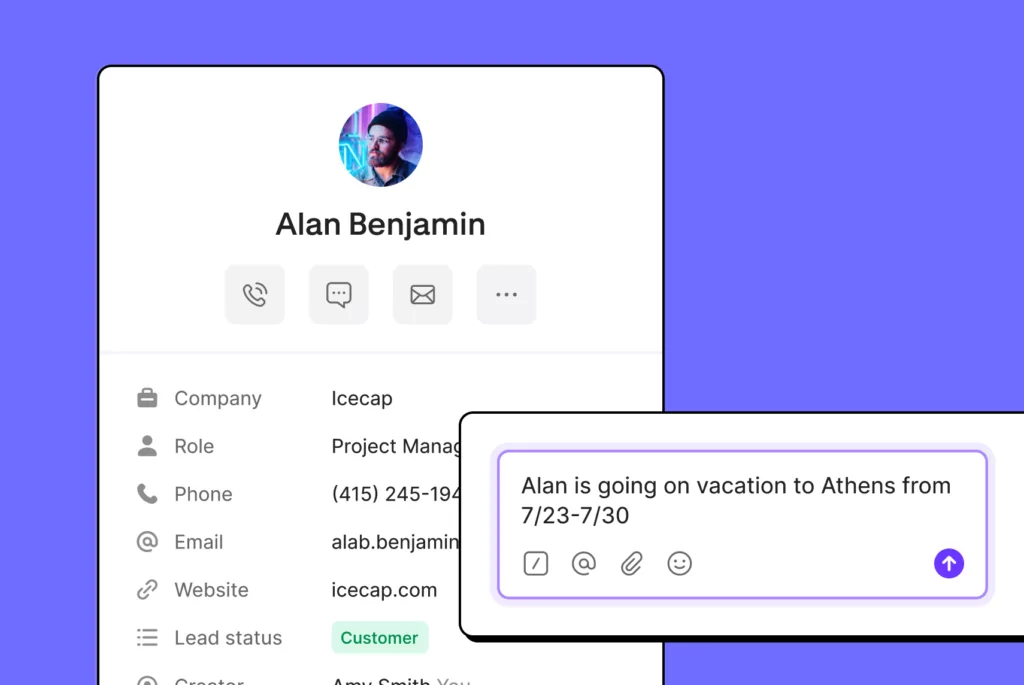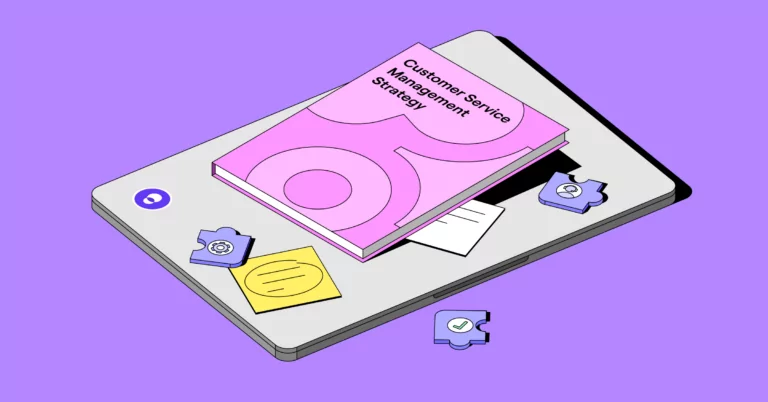We’ve all experienced the spectrum of customer service. At one end, we have the nightmare stories of unhelpful reps who don’t seem to care. And at the other, we have reps who resolve our issues quickly and make us smile in the process.
We know what a five-star customer service experience looks like. Whether it’s standard company practice or reps who are empowered to go the extra mile, we notice. It might be a personalized message or a customer support rep who works patiently with us until the issue is resolved.Whatever it is, it builds our trust in the business and its team.
Great customer service teams don’t happen by accident. They’re built by companies that know the business impact of customer service. A customer service management strategy helps the company thoughtfully and intentionally execute this vision.
I’ve led customer service teams at brands like LegalZoom and Evernote. In my experience, there are a few key ingredients great customer service teams have in common. In this article, I’ll share six essential steps to design and implement your own CSM strategy.
Any customer service department can prioritize handling issues quickly: that’s a bare minimum customer expectation. If their work isn’t efficient, customers will be frustrated, no matter how wonderful the rep is.
But great customer service management goes beyond efficiency.It also focuses on keeping customers happy and keeps them coming back, whether it’s buying more, renewing a subscription, or telling their friends about your great company.
According to Zendesk, over half of customer service reps say their organization’s approach to service can directly lead to negative experiences. You can’t leave interactions to chance: you need a thoughtful, intentional approach to customer service management.
If you’re watching a concert, you’re not thinking about the backstage crew that makes everything run smoothly. Lights, sound, equipment: many things come together to make that happen. Customer service management is the same, relying on many essential elements to make your customer’s experience a hit.
1. Define your customer service objectives
You can’t design a customer success management strategy without first understanding your goals.
When you ask yourself, “Where are we today?” start with what your customers want and work backward. Are your customers currently unsatisfied with response times or quality of service? Do they want more self-service options? Do you even have the data to know what your customers want, or do you need to survey them?
Once you’ve determined your customer needs, set clear, actionable, and time-bound goals. For example:
- If your customers are unhappy with response times, set a goal to reduce the average response time from 24 hours to 12 hours within the next quarter.
- If customers are expressing frustration about reaching out for simple problems, set a goal to develop and launch a knowledge base with FAQs and troubleshooting guides by the end of the year.
- When customers complain that getting any issues resolved over the phone with your team takes too long, focus on putting in processes and internal documentation that helps your reps reduce their average handle time during calls.
With your objectives in mind, you can develop the right customer success management strategy. When you know what you need to accomplish, you can move to the “how” part of your strategy. Once your specific tactics are in place, you can measure their success against your goals.
2. Properly assess your team bandwidth and structure
You might be tempted to jump into team structure as you design your CSM strategy. After all, it feels like a tangible way of making progress. You hire more people and you’ll be able to handle more volume and give customers more attention, right?
But focusing on customer service team structure early on is a distraction. You can’t truly assess your team’s bandwidth if structural issues (like inefficient systems) are in the way.
Maybe your reps are forced to escalate customer issues and wait in a queue when they could have handled the issues themselves. Maybe they spend too much time answering repetitive questions. If you give reps the tools they need to handle ticket volume more efficiently, you’ll see response times decrease.
Unless you have a clear indication that you need more reps, tackle your volume with your existing team structure. You need to remove your internal hurdles and streamline your processes. If you’re falling short and customers remain dissatisfied, then you can consider adding more people to the team.
Learn more about how to design the right customer team structure successfully.
3. Leverage automation to optimize team performance
Businesses should bebudget-conscious. You may need to add more people to your team, but can’t make any additional hires for budget reasons.
Customer service automation can help you do more with less. You’ll eliminate repetitive tasks from your team, saving them time in their daily work. Before you consider hiring additional people — even if you have the budget — you should make sure you’ve maximized automated workflows within your existing team.
Here are some low-effort, high-impact automations I recommend:
Message templates: If your team is typing the same response repeatedly, it should be a template. Most ticketing systems allow you to create templates that can be applied with a few clicks.
CX software macros: Macros take templates a step further. Macros replace steps within a workflow that a rep would otherwise do manually. For example, rather than simply replying with text, a macro might issue the customer a refund.
AI-powered chatbots: Customers can get quick responses to common questions through a chatbot. They don’t have to wait, which improves their experience and frees up reps to work on more complex questions.
Of course, you’ll always want to balance automation with the customer’s experience. No one wants to feel like they can’t reach a rep with their problem. You’ll want your strategy to be specific about when automation should be used and when an interaction needs a personal touch.

Learn how your team can implement customer service automations.
4. Invest in onboarding for new team members
Let’s say you’ve maximized your automations and still need to hire more customer service representatives. One of the worst mistakes I’ve seen companies make is failing to onboard the new team members well. They throw new reps into the mix before they’re ready. Unsurprisingly, these reps end up struggling amid a support team already struggling with high call volume. It doesn’t solve the problem and can increase churn if your reps lose motivation in their roles and don’t see a real solution.
But with the proper onboarding plan, you can set your new reps up for success — which will bolster your overall CSM strategy. I recommend the following:
- 1-2 weeks to learn about the business
- 2 weeks “nesting period” where you can supervise reps and give them real-time feedback
Even the most rigorous training program won’t cover every customer support scenario. A training manual can guide new reps during their onboarding period and serve as an ongoing resource.
Look back at your customer service objectives. You should be able to draw a line between the employee experience and your objectives. The time spent during the onboarding phase is time you save later because the new team members will be better equipped to contribute. And your customers will be happier with the service they receive if new reps aren’t struggling.
5. Build learning relationships to engage customers
While lowering your response times and automating support operations can improve customer satisfaction, how can you foster deep engagement — the type that creates true customer loyalty?
You can build learning relationships with your customers. You get to know them, adapt to their journey and needs, and work in ways that suit them best.
For example, Nike built a learning relationship with its customers in the early days. As described in the book Shoe Dog: A Memoir by the Creator of Nike, Nike founder and board chairman Phil Knight recalls that early salesperson Jeff Johnson would write each customer’s personal information, shoe size, and shoe preferences. Knight writes:
This database enabled Johnson to keep in touch with his customers, at all times, and to keep them all feeling special. He sent them Christmas cards. He sent them birthday cards. He sent them notes of congratulations after they completed a big race or marathon.
Customers wrote back to Johnson. The correspondence created meaningful relationships that went beyond their desire to purchase shoes from Nike.
These interactions will improve the customer experience and increase revenue. According to Zendesk, three in four customers will spend more with businesses that provide a good customer experience.
You can start small and achieve a lot more with modern tools to keep track of what you learn about customers. You can add notes to a shared resource or customer relationship management (CRM) software so anyone on the support team can reference the notes in future customer interactions.
OpenPhone’s custom properties and contact notes are great for this. If your reps work in OpenPhone, they can add notes directly in the app.

Check out other customer engagement strategies from iconic brands.
6. Test, measure, and repeat
You can’t manage what you don’t measure. If you have a goal to decrease your response time, you should create reports that can demonstrate improvement. If your goal is to improve customer satisfaction, you can rely on CSAT and NPS scores through surveys or collect open-ended customer feedback.
You can also track other efforts, such as providing self-service options or building learning relationships. Craig Stoss, Director of CX Transformation Delivery at PartnerHero, recommends businesses use KPIs like Customer Effort Score (CES) and Value Enhancement Score (VES). “Those are really important because [they] tell you if you have put too much onus on the customer or if the end result was not as useful as anticipated,” says Craig.
CES measures the ease with which customers can get their issues resolved. You can determine CES by asking customers questions like “How easy was it for you to resolve your issue?” on a scale of 1 to 5. You could also add a CES-related question to any self-serve articles or tutorials, such as “Did this answer your question?”
VES measures the perceived value a customer receives from your product or service. To calculate VES, ask customers questions like, “How would you rate the value you receive compared to the price you pay?” on a scale of 1 to 5. As you deepen relationships with customers, they’ll see more value because they’ll start to consider the benefits from your customer service team, in addition to the product itself.
Reviewing your metrics is a good start, but it isn’t enough. You have to test hypotheses against them to see what’s working and what isn’t. You’ll want to design small customer service experiments with a clear hypothesis and see how you do.
For example, you might have reps adopt a friendlier tone when interacting with customers. Or maybe you send a personalized welcome to new customers. Give your experiments enough time to demonstrate a clear result. That way, you can double down on what works.
Get inspiration for improving your customer satisfaction this year.
Put people at the forefront of your customer service management strategy
Each of these six essentials focuses on people. You’re providing a better experience for your customers and improving the work of your customer service reps. Both will lead to achieving your goals — because you’re treating people like humans, instead of numbers. You’re giving them the support they need.
When you design your customer service management strategy around people, you’ll always look for ways to make things better. By using the principles outlined in this article, you can develop a thoughtful approach that touches every aspect of the customer’s journey. Hopefully, customers and reps alike will be delighted by the interactions. After that, you’ll have to maintain that level of customer service as you scale.
Learn how we scaled our customer support operations to serve more than 58,000 customers.

